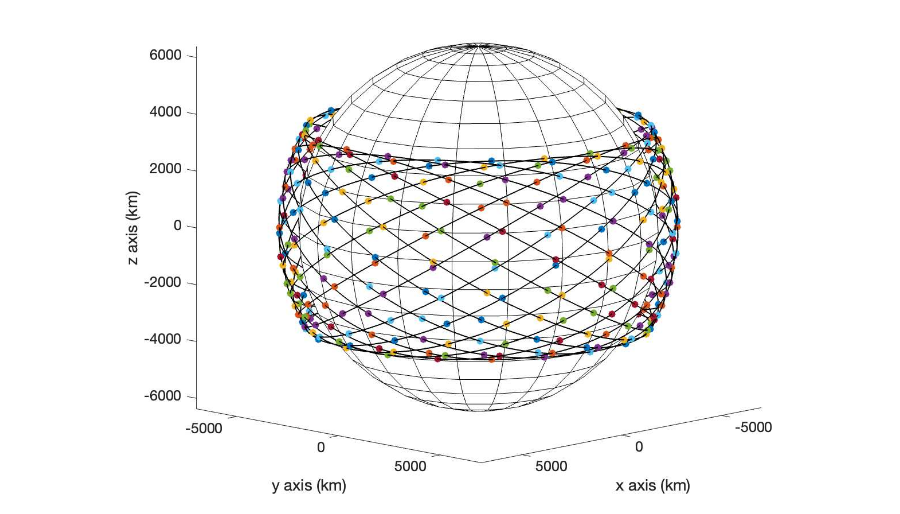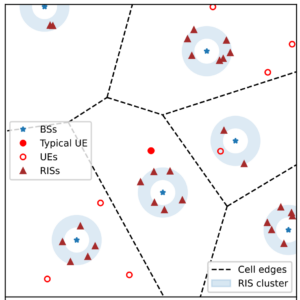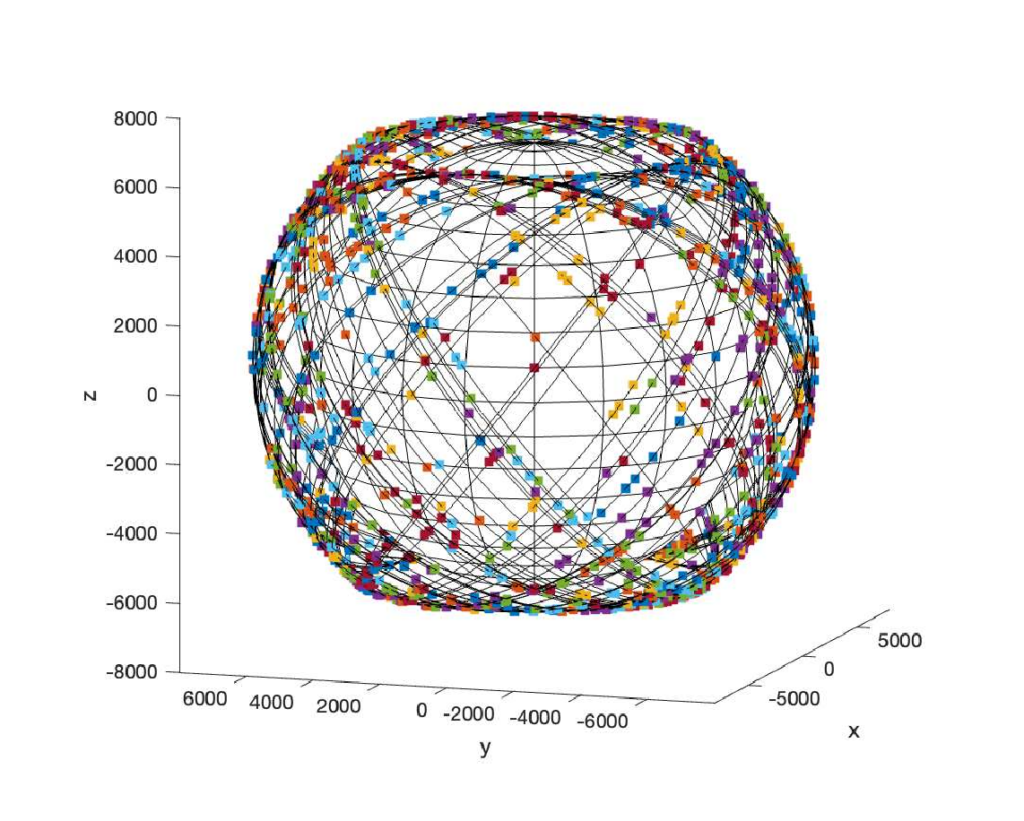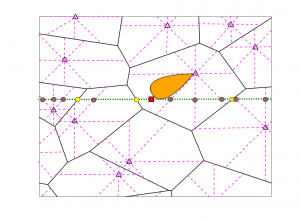Walker constellation based commmunication networks
Low Earth orbit (LEO) and medium Earth orbit (MEO) satellite networks consist of multiple orbits, each populated with many satellites. A widely used spatial architecture for satellites is the Walker constellation, where the longitudes of orbits are equally spaced and the satellites are periodically distributed along the orbits.
In this paper, we develop a stochastic geometry model for Walker constellations by constructing orbits that are invariant with respect to (w.r.t.) Earth’s spin and satellites that are invariant w.r.t. orbit-wise rotation.
This model enables an analysis based on dynamical systems, which allows one to address structural properties such as periodicity and ergodicity.
It also enables a stochastic geometry analysis where, for a typical user at a given latitude, we derive the performance of downlink communications as a function of key constellation parameters, including orbit inclination and altitude, the number of orbits, the number of satellites, and the user latitude.
- Chang-Sik Choi, Bon-Jun Ku, Francois Baccelli, “Stochastic Geometry and Dynamical System Analysis of Walker Constellation Networks”, ArXiv 2024 – https://arxiv.org/abs/2412.01610
RIS Enhanced Cellular Networks
The reconfigurable intelligent surface (RIS) technology allows one to engineer spatial diversity in complex cellular networks. This paper provides a framework for the system-level performance assessment of RIS-assisted networks and in particular downlink coverage probability and ergodic rate. To account for the inherent randomness in the spatial deployments of base stations (BSs) and RISs, we model the placements of the RISs as point processes (PPs) conditioned on the associated BSs, which are modeled by a Poisson point process (PPP). These RIS PPs can be adapted based on the deployment strategy. We focus on modeling the RISs as a Matérn cluster process (MCP), where each RIS cluster is a finite PPP with support a disc centered on the association BS. We assume that the system uses the orthogonal frequency division multiplexing (OFDM) technique to exploit the multipath diversity provided by RISs. The coverage probability and the ergodic rate can be evaluated when RISs operate as batched powerless beamformers. The resulting analytical expressions provide a general methodology to evaluate the impact of key RIS-related parameters, such as the batch size and the density of RISs, on system-level performance. To demonstrate the framework’s broad applicability, we also analyze a RIS placement variant where RISs are deployed around coverage holes. Numerical evaluations of the analytical expressions and Monte-Carlo simulations jointly validate the proposed analytical approach and provide valuable insights into the design of future RIS-assisted cellular networks.
- Guodong Sun, Francois Baccelli, Ke Feng, Luis Uzeda Garcia, Stefano Paris, “A Stochastic Geometry Framework for Performance Analysis of RIS-assisted OFDM Cellular Networks”, arXiv, 2023. https://arxiv.org/abs/2310.06754
Multiclass wireless birth-and-death processes
This work studies a multiclass spatial birth-and-death (SBD) processes on a compact region of the Euclidean plane modeling wireless interactions. In this model, users arrive at a constant rate and leave at a rate function of the interference created by other users in the network. The novelty of this work lies in the addition of service differentiation, inspired by bandwidth partitioning present in 5G networks: users are allocated a fixed number of frequency bands and only interfere with transmissions on these bands. The first result of the paper is the determination of the critical user arrival rate below which the system is stochastically stable, and above which it is unstable. The analysis requires symmetry assumptions which are defined in the paper. The proof for this result uses stochastic monotonicity and fluid limit models. The monotonicity allows one to bound the dynamics from above and below by two adequate discrete-state Markov jump processes, for which we obtain stability and instability results using fluid limits. This leads to a closed form expression for the critical arrival rate. The second contribution consists in two heuristics to estimate the steady-state densities of all classes of users in the network: the first one relies on a Poisson approximation of the steady-state processes. The second one uses a cavity approximation leveraging second-order moment measures, which leads to more accurate estimates of the steady-state user densities. The Poisson heuristic also gives a good estimate for the critical arrival rate.
- P. Popineau and F. Baccelli, “On multiclass spatial birth-and-death processes with wireless-type interactions”, arXiv, 2023. https://arxiv.org/abs/2205.15799
The results of the last paper rely on a symmetry assumption which is relaxed in
- P. Popineau, S. Shneer, “An instability condition for queueing systems with state-dependent departure rates”, ArXiv 2023 – https://arxiv.org/abs/2304.08853
Low Earch Orbit Satellite Constellation based Communication Networks
This work, in collaboration with Chang Sik Choi, develops an analytical framework for downlink low earth orbit (LEO) satellite communications, leveraging tools from stochastic geometry. We propose a tractable approach to the analysis of such satellite communication systems accounting for the fact that satellites are located on circular orbits. We accurately characterize this geometric property of such LEO satellite constellations by developing a Cox point process model that jointly produces orbits and satellites on these orbits.
Our work differs from existing modeling studies that have assumed satellites’ locations as completely random binomial point processes. For this newly developed Cox model, we derive the outage probability of the proposed network and the distribution of the signal-to-interference-plus-noise ratio (SINR) of an arbitrarily located user in the network.
By presenting various key network performance metrics as functions of key network parameters, this work allows one to assess the statistical properties of downlink LEO satellite communications and thus can be used as a system-level design tool.
- C.S. Choi, and F. Baccelli, ‘Modeling and Analysis of LEO Satellite Networks Leveraging Cox Point Processes’. IEEE Transactions on Communications (2024), Arxiv, 2022. https://doi.org/10.48550/arXiv.2212.03549
- C.S. Choi, and F. Baccelli, ‘Cox Point Processes for Multi-Altitude LEO Satellite Networks’.
IEEE Transactions on Vehicular Technology (2024), Arxiv, 2022.
https://arxiv.org/abs/2205.15799
Spatial Network Calculus
A new tool that combines the stochastic modeling of wireless networks using stationary point processes and the methodology of regulation/control from network calculus was introduced. It is based on spatial regulation properties for stationary spatial point processes and develops the first steps of a calculus for this regulation, which can be seen as an extension to space of the classical network calculus. Specifically, two classes of regulations are defined: one includes ball regulation and shot-noise regulation, which are shown equivalent and leads to upper bounds on the interference power; the other one includes void regulation, which lower constraints the signal power. These regulations are defined both in the strong and weak sense: the former requires the regulations to hold everywhere in space, whereas the latter only requires the regulations to hold as observed by a jointly stationary point process. Using this approach, we derive performance guarantees in device-to-device, ad hoc, and cellular networks under proper regulations, respectively. We give universal bounds on the SINR for all links, which gives link service guarantees based on information theoretic achievability. They are combined with classical network calculus to provide end-to-end latency guarantees for all packets in wireless queuing networks. Such guarantees do not exist in networks that are not spatially regulated, e.g., Poisson networks.
- K. Feng and F. Baccelli, ‘Spatial Network Calculus and Performance Guarantees in Wireless Networks’, Arxiv (2023), URL : https://doi.org/10.48550/arXiv.2302.02001, Under revision by Transactions on Wireless Communications.
Stochastic Geometry of Beam Management in 5G Networks
Beam management is central in the operation of dense 5G cellular networks. Focusing the energy radiated to mobile terminals by increasing the number of beams per cell increases signal power and decreases interference, and has hence the potential to bring major improvements on area spectral efficiency. This benefit, however, comes with unavoidable overheads that increase with the number of beams and the mobile terminal speed. In industry, this crucial problem of beam management is often studied using system-level simulations that are expensive and time-consuming. To accelerate system-level simulations, Sanket Kalamkar and Francois Baccelli from INRIA Paris and Luis G. Uzeda Garcia, Fuad Abinader and Andrea Marcano from Nokia Bell Labs Paris jointly proposed a first system-level stochastic geometry model encompassing major aspects of the beam management problem: frequencies, antennas, and propagation; physical layer, wireless links, and coding; network geometry, interference, and resource sharing; sensing, signaling, and mobility management. This model leads to a simple analytical expression for the effective area spectral efficiency that the typical user gets in this context. This in turn allows one to find, for a wide variety of 5G network scenarios including millimeter wave (mmWave) and sub-6 GHz, the number of beams per cell that offers the best global trade-off between these benefits and costs. This work also discusses different systemic trade-offs of mmWave and sub-6 GHz 5G deployments.
- S. Kalamkar, F. Baccelli, F. Abinader, A. Marcano and L. Uzeda Garcia, ‘Beam Management in 5G: A Stochastic Geometry Analysis’, IEEE Trans. Wirel. Commun., volume 21, number 4, pages 2275-2290, (2022), https://doi.org/10.1109/TWC.2021.3110785.
Beam management also leads to new natural stochatic geometry models investigated in
- F. Baccelli, S. S. Kalamkar, “On Point Processes Defined by Angular Conditions on Delaunay Neighbors in the Poisson-Voronoi Tessellation”, Journal of Applied Probability, 58(4), 2021. https://arxiv.org/abs/2010.16116
-
F. Baccelli, B. Liu, L. Decreusefond, and R. Song. ‘A User Centric Blockage Model for Wireless Networks’. In: IEEE Transactions on Wireless Communications (2022). https://hal.archives-ouvertes.fr/hal-03646854.
It also leads to new user association algorithms studied in
- P. Popineau, S. S. Kalamkar, F. Baccelli, “On Velocity-based Association Policies for Multi-tier 5G Wireless Networks”, Proceedings of IEEE Globecom 2021, December 2021.
Stochastic Geometry for Bandwidth Part in 5G Networks
Inspired by a new feature in 5G called bandwidth part (BWP), Francois Baccelli and Sanket S. Kalamkar proposed a bandwidth allocation (BA) model that allows one to adapt the bandwidth allocated to users depending on their data rate needs. Specifically, in adaptive BA, a wide bandwidth is divided into chunks of smaller bandwidths and the number of bandwidth chunks allocated to a user depends on its needs or type. Although BWP in 5G mandates allocation of a set of contiguous bandwidth chunks, the proposed BA model also allows other assumptions on chunk allocation such as the allocation of any set of bandwidth chunks, as in, e.g., LTE resource allocation, where chunks are selected uniformly at random. The proposed BA model is probabilistic in that the user locations are assumed to form a realization of a Poisson point process and each user decides independently to be of a certain type with some probability. This model allows one to quantify spectrum sharing and service differentiation in this context, namely to predict what performance a user gets depending on its type as well as the overall performance. This is based on exact representations of key performance metrics for each user type, namely its success probability, the meta distribution of its signal-to-interference ratio, and its Shannon throughput. Authors show that, surprisingly, the higher traffic variability stemming from adaptive BA is beneficial: when comparing two networks using adaptive BA and having the same mean signal and the same mean interference powers, the network with higher traffic variability performs better for all these performance metrics. With respect to Shannon throughput, the proposed BA model is roughly egalitarian per Hertz and leads to a linear service differentiation in aggregated throughput value.
- F. Baccelli and S.S. Kalamkar, “Bandwidth Allocation and Service Differentiation in D2D Wireless Networks,” Proceedings of the IEEE International Conference on Computer Communications IEEE INFOCOM, Toronto, Canada, July 2020. https://arxiv.org/abs/2108.11472
Sanket S. Kalamkar studied the effect of bandwidth partitioning on the reliability and delay performance in infrastructureless wireless networks in this 2019 Globecom paper. The reliability performance is characterized by the density of concurrent transmissions that satisfy a certain reliability (outage) constraint and the delay performance by so-called local delay, defined as the average number of time slots required to successfully transmit a packet. The focus is on the ultrareliable regime where the target outage probability is close to 0. The bandwidth partitioning has two conflicting effects: while the interference is reduced as the concurrent transmissions are divided over multiple frequency bands, the signal-to-interference ratio (SIR) requirement is increased due to smaller allocated bandwidth if the data rate is to be kept constant. Instead, if the SIR requirement is to be kept the same, the bandwidth partitioning reduces the data rate and in turn increases the local delay. For these two approaches with adaptive and fixed SIR requirements, the author has obtained closed-form expressions of the local delay and the maximum density of reliable transmissions in the ultrareliable regime. The analysis shows that, in the ultrareliable regime, the bandwidth partitioning leads to the reliability-delay tradeoff.
- S. S. Kalamkar, ” Reliability and Local Delay in Wireless Networks: Does Bandwidth Partitioning Help? ” December 2019, Proceedings of GLOBECOM 2019 – 2019 IEEE Global Communications Conference. https://arxiv.org/abs/1909.00913
Recent and Past Papers on the Stochastic Geometry Analysis of Wireless Networks Arranged by Topics
Beam Forming
- Beam Management in 5G, A Stochastic Geometry Analysis, Final version in EEE Trans. Wirel. Commun., volume 21, number 4, pages 2275-2290, 2022.
- On Point Processes Defined by Angular Conditions on Delaunay Neighbors in the Poisson-Voronoi Tessellation, Final version in the Journal of Applied Probability, 58(4), 2021.
- A User Centric Blockage Model for Wireless Networks. Final version in IEEE Transactions on Wireless Communications 2022.
Cellular Networks
- A Tractable Approach to Cellular Network Modeling, Final version in IEEE Transactions on Communications, Vol. 59, No. 11, pp. 3122-3134, 2011.
- Modeling and Analysis of K-Tier Downlink Heterogeneous Cellular Networks, Final version in IEEE Journal on Selected Areas in Communications, Vol. 30, No. 2, pp. 550-560, 2012.
Cognitive Radio Networks
- A Stochastic Geometry Model for Cognitive Radio Networks, Final version in The Computer Journal, Vol. 55, No. 5, pp. 534-552, 2012.
Connectivity and Coverage
- On a Coverage Process Ranging from the Boolean Model to the Poisson-Voronoi Tessellation, Final version in Advances in Applied Probability, 33, pp. 293-323, 2001.
- Impact of Interference on the Connectivity of Ad Hoc Networks, Final version in IEEE Transactions on Networking, Volume 13, Number 1, Feb. 2005
Cooperation
- Coverage by Pairwise Base Station Cooperation under Adaptive Geometric Policies, Final version in IEEE Transactions on Wireless Communications, 14(2): 794-808, 2014.
CSMA
- Volume II of the book Spatial Modeling of Wireless Communications — A Stochastic Geometry Approach, 2009.
- On Optimizing CSMA for Wide Area Ad-hoc Networks, Final version in Queueing Systems, Vol. 72, No. 1-2, pp. 31-68, 2012.
- Modeling and Analyzing the Coexistence of Wi-Fi and LTE in Unlicensed Spectrum, Final version in IEEE Trans. Wireless Communications, 15(9): 6310-6326, 2016.
Device-to-Device
- An Aloha Protocol for Multi-hop Mobile Wireless Networks, Final version in IEEE Transactions on Information Theory. Vol. 52, No. 2, pp. 421–436, Jan. 2006.
- Stochastic analysis of spatial and opportunistic Aloha, Final version in IEEE JSAC, Vol. 27, pp. 1105-1119, 2009.
- Analysis of a Proportionally Fair and Locally Adaptive spatial Aloha in Poisson Networks, Final version in the Proceedings of IEEE INFOCOM 2014.
Dynamics
- Spatial Birth-Death Wireless Networks, Final version in IEEE Tr. Information Theory, 63(6), pp. 3964-3982, 2017
- Interference Queueing Networks on Grids. Final version in Annals Applied Probability, 29(5): 2929-2987, 2019.
- Stability and Metastability of Traffic Dynamics in Uplink Random Access Networks, Preprint, 2020.
General
- Spatial Modeling of Wireless Communications – A Stochastic Geometry Approach, Volume I, 2009.
- Spatial Modeling of Wireless Communications – A Stochastic Geometry Approach, Volume II, 2009.
Initial Access
- Design and Analysis of Initial Access in Millimeter Wave Cellular Networks, Final version in IEEE Transactions on Wireless, Volume: 16 Issue: 10 2017.
- Directional Cell Search Delay Analysis for Cellular Networks With Static Users, Final version in IEEE Transactions on Communications, Volume: 66 Issue: 9, 2018.
Internet of Things
- Densification Leveraging Mobility: An IoT Architecture Based on Mesh Networking and Vehicles, Proceedings of ACM MobiHoc 2018, pp. 71–80}, June 2018.
Shadowing
- A correlated shadowing model for urban wireless networks, Final version in the Proceedings of IEEE INFOCOM 2015.
- A 3-D Spatial Model for In-Building Wireless Networks With Correlated Shadowing, Final version in IEEE Trans. Wireless Communications, 15(11): 7778-7793, 2016.
- On the Effect of Shadowing Correlation on Wireless Network Performance, Final version in the Proceedings of IEEE INFOCOM 2018.
Spectral efficiency
- Spectral Efficiency Scaling Laws in Dense Random Wireless Networks With Multiple Receive Antennas, Final version in IEEE Trans. Information Theory 62(3): 1344-1359, 2016.
- SINR and Throughput of Dense Cellular Networks with Stretched Exponential Path Loss, Final version in IEEE Transactions on Wireless Communications, Volume 17, Number 2, pp. 1147–1160, 2018
- A Unified Asymptotic Analysis of Area Spectral Efficiency in Ultradense Cellular Networks, Final version in IEEE Trans. Information Theory, 65(2): 1236-1248, 2019.
Vehicular Networks
- Poisson Cox Point Processes for Vehicular Networks, Final version in IEEE Tr. Vehicular Tech. 2018.
- Shared Rate Process for Mobile Users in Poisson Networks and Applications, Final version in IEEE Trans. Information Theory, Volume 64, Number 3, pp. 2121–2141, 2018.
- An Analytical Framework for Coverage in Cellular Networks Leveraging Vehicles, Final version in IEEE Trans. Commun, 66(10), pp. 4950-4964, 2019.
- Modeling and Analysis of Data Harvesting Architecture Based on Unmanned Aerial Vehicles, Final version in IEEE Trans. Wirel. Commun, 19(3), pp. 1825-1838, 2020.
- Analysis of Vehicular Safety Messaging in Cellular Networks, Final version in IEEE Transactions on Wireless Communications, 20/7, 2021.
- A Stochastic Geometry Model for Spatially Correlated Blockage in Vehicular Networks, Final version in IEEE Internet of Things Journal, volume 9, pages 19881-19889, October 2022.
- LOS Coverage Area in Vehicular Networks with Cox-Distributed Roadside Units and Relays, IEEE Trans. Veh. Technol., volume 72, number 6, pages 7772–7782, June 2023.




